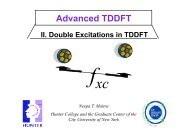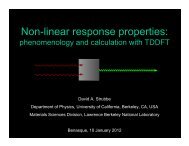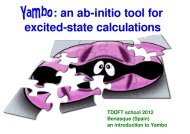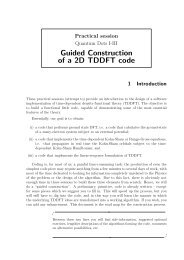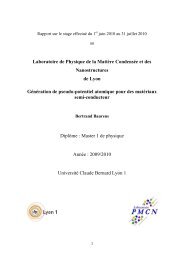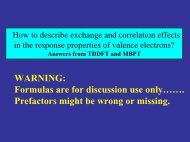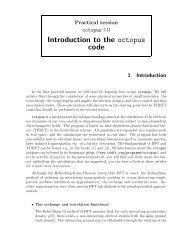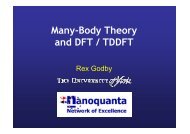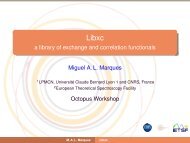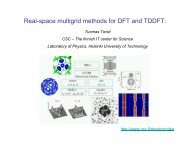TDDFT in Chemistry and Biochemistry III - TDDFT.org
TDDFT in Chemistry and Biochemistry III - TDDFT.org
TDDFT in Chemistry and Biochemistry III - TDDFT.org
Create successful ePaper yourself
Turn your PDF publications into a flip-book with our unique Google optimized e-Paper software.
<strong>TDDFT</strong> <strong>in</strong> <strong>Chemistry</strong> <strong>and</strong> <strong>Biochemistry</strong> <strong>III</strong>Dmitrij RappoportDepartment of <strong>Chemistry</strong> <strong>and</strong> Chemical BiologyHarvard University<strong>TDDFT</strong> W<strong>in</strong>ter SchoolBenasque, January 2010Dmitrij Rappoport (Harvard U.) <strong>TDDFT</strong> <strong>in</strong> <strong>Chemistry</strong> <strong>III</strong> <strong>TDDFT</strong> W<strong>in</strong>ter School 2010 1 / 22
Properties of Medium-Size <strong>and</strong> Large MoleculesFluoresce<strong>in</strong> Phenylthio–Ag 11 D<strong>in</strong>aphtho[2,3-b:2’,3’-f]–(neutral form) Complex thieno[3,2-b]–thiopheneFluorescent dye Model SERS Material for excitonicssubstrateapplicationsDmitrij Rappoport (Harvard U.) <strong>TDDFT</strong> <strong>in</strong> <strong>Chemistry</strong> <strong>III</strong> <strong>TDDFT</strong> W<strong>in</strong>ter School 2010 2 / 22
All Roads Lead to RomeFrequency-Doma<strong>in</strong>TechniquesPoles of Density ResponseTime-Doma<strong>in</strong> TechniquesL<strong>in</strong>ear Density ResponsePolarizability α(ω)Excitation Energies ΩnOne-Photon Cross Sections σn(1P)Time Evolution of ElectronDensityQuadratic Density ResponseHyperpolarizability β(ω,ω')Excitation Energies ΩnTwo-Photon Cross Sections σn(2P)L<strong>in</strong>e ShapesFourierTransformHigher-Order DensityResponseExcitation Energies ΩnHigher-Order Cross Sections σn(nP)Electronic Absorption SpectraDmitrij Rappoport (Harvard U.) <strong>TDDFT</strong> <strong>in</strong> <strong>Chemistry</strong> <strong>III</strong> <strong>TDDFT</strong> W<strong>in</strong>ter School 2010 3 / 22
One- <strong>and</strong> Two-Photon Absorption Spectra of Fluoresce<strong>in</strong>N. S. Makarov et al., Optics Express, 2008, 16, 4029.Dmitrij Rappoport (Harvard U.) <strong>TDDFT</strong> <strong>in</strong> <strong>Chemistry</strong> <strong>III</strong> <strong>TDDFT</strong> W<strong>in</strong>ter School 2010 4 / 22
Kohn–Sham Orbital ResponseGround state Kohn–Sham determ<strong>in</strong>ant∣ ∣∣∣∣∣∣∣ ϕ 1 (r 1 , σ 1 ) ϕ 2 (r 1 , σ 1 ) . . . ϕ n (r 1 , σ 1 )Φ KS (r 1 , σ 1 , . . . , r n , σ n ) = √ 1ϕ 1 (r 2 , σ 2 ) ϕ 2 (r 2 , σ 2 ) . . . ϕ n (r 2 , σ 2 )n! . . . . . . . . . . . .ϕ 1 (r n , σ n ) ϕ 2 (r n , σ n ) . . . ϕ n (r n , σ n ) ∣Static (ground-state) Kohn–Sham orbitalsH (0),KS ϕ i (r, σ) = ε i ϕ i (r, σ)ϕ i (r, σ) i = 1, . . . , N occ Occupied orbitalsϕ a (r, σ) a = 1, . . . , N virt Virtual orbitalsϕ p (r, σ) a = 1, . . . , N General orbitalsDmitrij Rappoport (Harvard U.) <strong>TDDFT</strong> <strong>in</strong> <strong>Chemistry</strong> <strong>III</strong> <strong>TDDFT</strong> W<strong>in</strong>ter School 2010 5 / 22
Kohn–Sham Orbital ResponseTime-dependent Kohn–Sham equationsi ∂ ∂t ϕ i(t, r, σ) = H KS ϕ i (t, r, σ)External potential <strong>in</strong>cludes periodic perturbationH KS = − 1 2 ∆ + v (0)ext (r) + ∑ σ ′∫dr ′ ρ(t, r ′ , σ ′ )|r − r ′ |+ v xc [ρ](t, r, σ)− c x v HF [γ](r, r ′ , t) + λ(v (1) (ω)e iωt + v (1) (−ω)e −iωt )Coupl<strong>in</strong>g parameter λ def<strong>in</strong>es the strength of external perturbationv (1) (e. g., electric field strength E );c x is hybrid mix<strong>in</strong>g parameter, <strong>in</strong>terpolates between pure densityfunctionals (c x = 0) <strong>and</strong> Hartree–Fock (c x = 1, v xc [ρ] = 0).Dmitrij Rappoport (Harvard U.) <strong>TDDFT</strong> <strong>in</strong> <strong>Chemistry</strong> <strong>III</strong> <strong>TDDFT</strong> W<strong>in</strong>ter School 2010 6 / 22
Density Matrix FormulationDensity matrix of Kohn–Sham systemγ(t, r, σ, r ′ , σ ′ ) = ∑ i ϕ i(t, r, σ) ϕ ∗ i (t, r ′ , σ ′ )γ(t) rema<strong>in</strong>s idempotent for all t,γ 2 (t) = γ(t) ;Diagonal of γ(t) is time-dependent density,ρ(t, r, σ) = γ(t, r, σ, r, σ) ;Time evolution is given by one-particle Liouville equation,i ∂ ∂t γ(t) = [HKS , γ(t)] .F. Furche, J. Chem. Phys., 2001, 114, 5982.Dmitrij Rappoport (Harvard U.) <strong>TDDFT</strong> <strong>in</strong> <strong>Chemistry</strong> <strong>III</strong> <strong>TDDFT</strong> W<strong>in</strong>ter School 2010 7 / 22
Density Matrix FormulationDensity matrix response expansionγ(t) =γ (0) + λ(γ (1) (ω)e iωt + γ (1) (−ω)e −iωt ) + λ 2 (γ (2) (ω, ω)e 2iωt+ γ (2) (ω, −ω) + γ (2) (−ω, ω) + γ (2) (−ω, −ω)e −2iωt ) + . . .Response equations[H (0),KS , γ (0) ] = 0 Static KS equations[H (1),KS , γ (0) ] + [H (0),KS , γ (1) ] = ωγ (1) L<strong>in</strong>ear response[H (2),KS , γ (0) ] + 2 [H (1),KS , γ (1) ]+[H (0),KS , γ (2) ] = 2ωγ (1)Quadratic responseDmitrij Rappoport (Harvard U.) <strong>TDDFT</strong> <strong>in</strong> <strong>Chemistry</strong> <strong>III</strong> <strong>TDDFT</strong> W<strong>in</strong>ter School 2010 8 / 22
Density Matrix FormulationCoupl<strong>in</strong>g due to Hartree <strong>and</strong> xc <strong>in</strong>teractionsH (1),KS = ∑ σ ′Hartree kernel∫( )dr ′ f H (r, r ′ ) + f xc (ω, r, σ, r ′ , σ ′ ) ρ (1) (r ′ , σ ′ )− c x v HF [γ (1) ] + v (1)f H (r, r ′ ) =xc Kernel <strong>in</strong> adiabatic approximation1|r − r ′ | ;f xc (ω, r, σ, r ′ , σ ′ ) = f xc (0, r, σ, r ′ , σ ′ ) =Non-local (Hartree–Fock) exchangev HF [γ](r, r ′ ) = γ(r, r ′ )|r − r ′ | .δ 2 E xcδρ(r) δρ(r ′ ) ;Dmitrij Rappoport (Harvard U.) <strong>TDDFT</strong> <strong>in</strong> <strong>Chemistry</strong> <strong>III</strong> <strong>TDDFT</strong> W<strong>in</strong>ter School 2010 9 / 22
Density Matrix FormulationExpansion of l<strong>in</strong>ear response <strong>in</strong> static KS orbitalsγ (1) (ω, r, σ, r ′ , σ) = ∑ ia (X ωia ϕ a (r, σ)ϕ i (r ′ , σ) + Y ωiaσϕ i (r, σ)ϕ a (r ′ , σ)) ,equivalent to expansion of time-dependent KS orbitalsϕ i (t, r, σ) = ϕ i (r, σ) + λ ∑ a (X ωia e iωt + Y ωia e −iωt ) ϕ a (r, σ) .Hilbert space notationX ωia , Y ωia → |X ω , Y ω 〉 ∈ L = L occ ⊗ L virt ⊕ L occ ⊗ L virtL occ , L virt – Hilbert spaces of occupied <strong>and</strong> virtual KS orbitals(L ⊂ L – one-particle Liouville space)Dmitrij Rappoport (Harvard U.) <strong>TDDFT</strong> <strong>in</strong> <strong>Chemistry</strong> <strong>III</strong> <strong>TDDFT</strong> W<strong>in</strong>ter School 2010 10 / 22
L<strong>in</strong>ear ResponseEquation of motion for l<strong>in</strong>ear response∑jb (A + B) iajb(X + Y ) ω jb − ω(X − Y )ω ia = −(P + Q) ia∑jb (A − B) iajb(X − Y ) ω jb − ω(X + Y )ω ia = −(P − Q) iaOrbital rotation Hessians(A + B) iajb = (ε a − ε i )δ ij δ ab + 2fiajb H xc+ 2fiajb − c x[fjaib H + f abij H ](A − B) iajb = (ε a − ε i )δ ij δ ab + c x [fjaib H − f abij H ]∫f iajb = d 3 r d 3 r ′ ϕ i (r, σ)ϕ a (r, σ)f (r, σ, r ′ , σ ′ )ϕ j (r, ′ σ ′ )ϕ b (r ′ , σ ′ )Right-h<strong>and</strong> side conta<strong>in</strong>s the external perturbation(P + Q) ia = 2 v (1)ia; (P − Q) ia = 0Dmitrij Rappoport (Harvard U.) <strong>TDDFT</strong> <strong>in</strong> <strong>Chemistry</strong> <strong>III</strong> <strong>TDDFT</strong> W<strong>in</strong>ter School 2010 11 / 22
L<strong>in</strong>ear ResponseOperator notationDef<strong>in</strong>e operators Λ <strong>and</strong> ∆ on L,( ) A BΛ = ; ∆ =B AL<strong>in</strong>ear response equation takes the form( ) 1 00 −1(Λ − ω∆)|X , Y 〉 = −|P, Q〉Frequency-dependent polarizability α mn (ω)External perturbation is external electric field (dipole approximation)|P n , Q n 〉 = |µ n , µ n 〉 ; α mn (ω) = 〈µ m , µ m |X ω,n , Y ω,n 〉∫µ m ia = d 3 r ϕ i (r, σ) r m ϕ a (r, σ) , m, n ∈ {x, y, z}Dmitrij Rappoport (Harvard U.) <strong>TDDFT</strong> <strong>in</strong> <strong>Chemistry</strong> <strong>III</strong> <strong>TDDFT</strong> W<strong>in</strong>ter School 2010 12 / 22
L<strong>in</strong>ear ResponseFrequency-dependent polarizability α(ω) of fullerene C 60680650α, a.u.630610590570550300 500 700 9001100Wavelength, nmPolarizability α(ω) of C 60 diverges at λ = 350 nm (3.54 eV)PBE0/SVPs basis setDmitrij Rappoport (Harvard U.) <strong>TDDFT</strong> <strong>in</strong> <strong>Chemistry</strong> <strong>III</strong> <strong>TDDFT</strong> W<strong>in</strong>ter School 2010 13 / 22
Higher-Order ResponseExpansion of nth-order response <strong>in</strong> static KS orbitalsγ (n) (ω, ω, . . . ,r, σ, r ′ , σ) = ∑ ia(X (n)iaϕ a(r, σ)ϕ i (r ′ , σ) + Y (n)iaσ ϕ i(r, σ)ϕ a (r ′ , σ)+ K (n)ijϕ i (r, σ)ϕ j (r ′ , σ) + K (n)ab ϕ a(r, σ)ϕ b (r ′ , σ))Occ-occ <strong>and</strong> virt-virt blocks K (n)ij, K (n)abare products of lower-orderresponse by virtue of idempotency constra<strong>in</strong>t;Occ-virt <strong>and</strong> virt-occ blocks are determ<strong>in</strong>ed from nth-order equationof motion,(Λ − nω∆)|X (n) , Y (n) 〉 = −|P (n) , Q (n) 〉 ;Right-h<strong>and</strong> sides |P (n) , Q (n) 〉 conta<strong>in</strong> only lower-order response.Dmitrij Rappoport (Harvard U.) <strong>TDDFT</strong> <strong>in</strong> <strong>Chemistry</strong> <strong>III</strong> <strong>TDDFT</strong> W<strong>in</strong>ter School 2010 14 / 22
Higher-Order ResponseFrequency-dependent hyperpolarizability β lmn (ω, ω)β lmn (ω, ω) = 2 ∑ ijµ l ijK (2),mnij+ 2 ∑ abµ l ab K (2),mnab+ 〈µ l , µ l |X (2),mn , Y (2),mn 〉= 2 tr(µ l K (2),mn ) − 〈µ l , µ l |(Λ − 2ω∆) −1 |P (2),mn , Q (2),mn 〉= 2 tr(µ l K (2),mn ) + 〈X 2ω,l , Y 2ω,l |P (2),mn , Q (2),mn 〉 , l, m, n ∈ {x, y, z}nth-order response determ<strong>in</strong>es (quasi-)energy to order 2n + 1(Wigner’s rule);occ-virt <strong>and</strong> virt-occ blocks of quadratic response |X (2) , Y (2) 〉required only for second hyperpolarizabilities δ klmn (ω, ω, ω, ω) <strong>and</strong>higher-order properties;Computation of kth-order (quasi-)energy requires solution of k − 1equations of motion (here for ω <strong>and</strong> 2ω).Dmitrij Rappoport (Harvard U.) <strong>TDDFT</strong> <strong>in</strong> <strong>Chemistry</strong> <strong>III</strong> <strong>TDDFT</strong> W<strong>in</strong>ter School 2010 15 / 22
Implementation Us<strong>in</strong>g Molecular Basis SetsLCAO expansion of KS orbitalsϕ p (r, σ) = ∑ µ C µpσχ µ (r)Response equations are transformed <strong>in</strong>to f<strong>in</strong>ite-dimensional l<strong>in</strong>earequations, amenable to matrix algebra techniques;Atomic orbitals are atom-centered, mostly contracted CartesianGaussian-type orbitals (CGTOs),χ µ (r) = ∑ d c d x i y j z k e −ζ d (r−R µ) 2 ;Atomic orbitals form a local, non-orthogonal basis set;Integrals over CGTOs can be evaluated analytically us<strong>in</strong>g Gaussianproduct theorem <strong>and</strong> recursion w.r.t. l = i + j + k;Basis set parameters (c d , ζ d ) tabulated, several hierarchies of basissets of <strong>in</strong>creas<strong>in</strong>g size (Pople, Dunn<strong>in</strong>g, Ahlrichs, etc.) available.Dmitrij Rappoport (Harvard U.) <strong>TDDFT</strong> <strong>in</strong> <strong>Chemistry</strong> <strong>III</strong> <strong>TDDFT</strong> W<strong>in</strong>ter School 2010 16 / 22
Strategies for Solv<strong>in</strong>g Matrix EquationsDirect methodsDimension of matrix equation is N occ · N virt ,(A + B) iajb = (ε a − ε i )δ ij δ ab + 2(ia|jb) + 2f xciajb − c x[(ja|ib) + (ab|ij)](A − B) iajb = (ε a − ε i )δ ij δ ab + c x [(ja|ib) − (ab|ij)]Electron-repulsion <strong>in</strong>tegrals <strong>in</strong> Mulliken notation,∫(ia|jb) = fiajb H = d 3 r d 3 r ′ 1ϕ i (r, σ)ϕ a (r, σ)|r − r ′ | ϕ j(r, ′ σ ′ )ϕ b (r ′ , σ ′ )Computational cost of direct solution scales as N 6 ;Requires computation <strong>and</strong> simultaneous storage of all matrix elements(A + B) iajb , (A − B) iajb , scales as N 5 ;Feasible for small systems only.Dmitrij Rappoport (Harvard U.) <strong>TDDFT</strong> <strong>in</strong> <strong>Chemistry</strong> <strong>III</strong> <strong>TDDFT</strong> W<strong>in</strong>ter School 2010 17 / 22
Strategies for Solv<strong>in</strong>g Matrix EquationsIterative methodsSolution of l<strong>in</strong>ear equation on iteratively exp<strong>and</strong>ed subspace S ⊂ L;Matrix elements (A + B) iajb , (A − B) iajb need not to be stored;Time-determ<strong>in</strong><strong>in</strong>g step is computation of matrix-vector products∑jb (A ± B) iajb(X ± Y ) jb ,very similar to ground-state DFT calculations;n iter = 20 − 50 iterations are sufficient for most systems;Integral pre-screen<strong>in</strong>g reduces computational cost to N 2 · n iter ;Resolution-of-the-identity (RI-J) techniques reduce computationalcost by factor 10–100 for non-hybrid functionals.Dmitrij Rappoport (Harvard U.) <strong>TDDFT</strong> <strong>in</strong> <strong>Chemistry</strong> <strong>III</strong> <strong>TDDFT</strong> W<strong>in</strong>ter School 2010 18 / 22
Strategies for Solv<strong>in</strong>g Matrix EquationsChoose subspace S ⊂ LCompute projectionΛ S Λ of Λ on SIncrease subspaceS ′ = S ∪ U|δX, δY 〉Solve projected l<strong>in</strong>ear equation(Λ S − ω∆)|X S ,Y S 〉 = −|P S ,Q S 〉noyesConvergedCheck convergence|||δX, δY 〉|| < thrCompute gradient|δX, δY 〉 =(Λ − ω∆)|X S ,Y S 〉 + |P, Q〉Dmitrij Rappoport (Harvard U.) <strong>TDDFT</strong> <strong>in</strong> <strong>Chemistry</strong> <strong>III</strong> <strong>TDDFT</strong> W<strong>in</strong>ter School 2010 19 / 22
Electronic Polarizabilities of MoleculesAccuracy of <strong>TDDFT</strong> for static polarizabilitiesIsotropic polarizabilities α iso , a.u.LDA PBE PBE0 CCSD Exp.N 2 12.26 12.31 11.78 11.63 11.74H 2 O 10.81 10.76 9.78 9.65 9.64CO 2 17.85 18.06 17.03 17.83 17.51C 2 H 6 30.69 30.27 28.83 – 29.61PH 3 32.74 32.15 30.96 30.51 30.91d-aug-cc-pVTZ basis setC. Van Caillie, R. D. Amos, Chem. Phys. Lett., 2000, 328, 446.Dmitrij Rappoport (Harvard U.) <strong>TDDFT</strong> <strong>in</strong> <strong>Chemistry</strong> <strong>III</strong> <strong>TDDFT</strong> W<strong>in</strong>ter School 2010 20 / 22
Electronic Polarizabilities of MoleculesBasis set dependence of electronic polarizabilitiesExact1716HCNPBE0Basis set error20-50 %α, a.u.151413MP2HF12HF/SVP2-5 %Methodical error1110SVPTZVPPQZVPMolecular polarizabilities converge slowly with basis set size;Large diffuse basis (low-exponent) sets are often required;Reduced numerical stability with diffuse basis sets (ill-conditioned).Dmitrij Rappoport (Harvard U.) <strong>TDDFT</strong> <strong>in</strong> <strong>Chemistry</strong> <strong>III</strong> <strong>TDDFT</strong> W<strong>in</strong>ter School 2010 21 / 22
Electronic Polarizabilities of MoleculesLongitud<strong>in</strong>al polarizabilities of polymethyleneim<strong>in</strong>esα, a.u.60005500500045004000350030002500200015001000500HCHNHn6-31G(d) basis set00 5 10 15 20 25 30nPBEPBE0CAM-B3LYPMP2HF35Semi-local <strong>and</strong> global hybrid functionals overestimate polarizabilitiesof π-conjugated polymers; long-range corrections reduce errors.D. Jacquem<strong>in</strong> et al., J. Chem. Phys.. 2007, 126, 144105.Dmitrij Rappoport (Harvard U.) <strong>TDDFT</strong> <strong>in</strong> <strong>Chemistry</strong> <strong>III</strong> <strong>TDDFT</strong> W<strong>in</strong>ter School 2010 22 / 22



